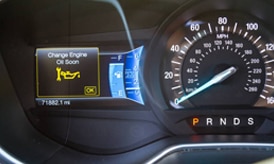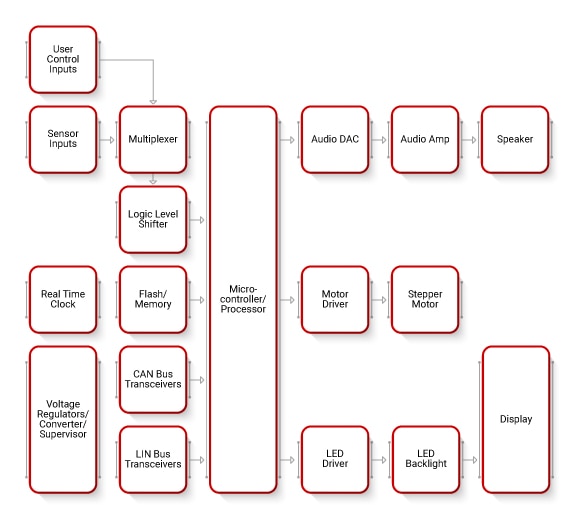Products in this family are used for the conversion of information between analog and digital representations and are adapted for specific use cases or integrate additional features or functionality not commonly encountered in general-purpose data converters. Examples include devices that integrate low-noise amplifiers and variable gain stages for ultrasound or automotive radar applications, audio and video focused products, devices that integrate functionality to indicate measured values on segmented displays, devices integrating galvanic isolation between input and output, and others.
Products in the audio amplifier integrated circuit (IC) family are designed specifically for replicating signal-level audio content at increased power levels sufficient to drive headphones, speakers, or similar transducers. Features such as mute inputs, volume controls, and anti-transient (depop) functions distinguish them from general purpose amplifiers. Audio amplifier classes of all types are included such as devices based on Class A, Class D, Class G topologies and others, as well as devices that integrate additional functionality such as analog-to-digital conversion in addition to the amplification function.
Logic buffers, drivers, receivers and transceivers allow isolated access to logic signals from one circuit for use in another circuit. Buffers pass their input signal, either unchanged or inverted, to their output and may be used to clean up a weak signal or drive a load. In a boolean logic simulator, a buffer is mainly used to increase propagation delay. Logic receivers and transceivers allow isolated communication between data buses.
Devices in the LED driver PMIC (Power Management Integrated Circuit) family are used to supply a current flow of controlled value to a load, typically a Light Emitting Diode, from a power source having a nominally fixed voltage. Key differentiators from the very similar products designed for voltage regulation include a characteristically lower feedback voltage (to improve system efficiency) and high prevalence of provisions for external control of the device's operating point, used to implement dimming functions in lighting applications.
Logic buffers, drivers, receivers and transceivers allow isolated access to logic signals from one circuit for use in another circuit. Buffers pass their input signal, either unchanged or inverted, to their output and may be used to clean up a weak signal or drive a load. In a boolean logic simulator, a buffer is mainly used to increase propagation delay. Logic receivers and transceivers allow isolated communication between data buses.
Logic translator or level shifter ICs are devices used to pass information between digital logic devices that are operating from different/incompatible supply voltages, or which implement different signaling methods. Examples might include the connection of a digital-output sensor requiring a 5 V supply to an FPGA with a 3.3 V I/O supply, or converting between single-ended signaling methods like CMOS or TTL and differential techniques, such as PECL or LVDS.
Memory is a semiconductor device that is used as data storage device on an integrated circuit. These devices are available in several formats CBRAM, DRAM, EEPROM, EERAM, EPROM, Flash, FRAM, NVSRAM, PCM (PRAM), PSRAM, RAM, and SRAM in either Non-Volatile or Volatile. These devices memory sizes range from 64 b to 6 Tb with the interface being I2C, MMC, Parallel, eMMC, Serial, Single Wire, SPI, UFS, Xccela Bus, and 1-Wire.
Products in the modular embedded processor family integrate a microcontroller, microprocessor, digital signal processor, FPGA, or other such computational device together with support components such as memory, power management, timing, and other items necessary for their operation. They are suitable and intended for integration into an end product, and offer product developers access to modern computational and interface capabilities without necessity of high speed hardware design experience.
Products in the motor driver and controller PMIC (Power Management Integrated Circuit) family are used to control or manipulate the application of power from some source to electric motors or related electromechanical actuators. The precise functionality and feature sets implemented vary widely depending on the characteristics of the intended load and expected application, ranging from simple open-loop speed control for brushed motors to advanced, closed-loop, stepper-based motion control.
Logic type signal switch, multiplexer, and encoder ICs are used for routing and selection of electrical signals used to represent data in digital format. They differ from similar products designed for use with analog signals in that they are designed to preserve information represented as one of two electrical states, rather than as an infinitely variable quantity within two outer limits.
Real Time Clocks (RTCs) provide time and/or date information in almost any electronic device which needs to keep accurate time. The clock types are binary counter, clock/calendar/supervisor, elapsed time counter, phantom time chip, portable system controller, temperature recorder, time event recorder, and timer clock peripheral. They contain memory sizes ranging from 2 B to 2 MB and have interface options of I2C, Parallel, Serial, SPI, 1-Wire, 2-Wire, 3-Wire, and 4-Wire.
Speaker products are audio frequency electromagnetic transducers used primarily to turn energy in the format of an electrical signal into mechanical compression waves travelling through an atmospheric air environment for reproduction of speech, music, or similar material. Products designed for general purpose reproduction of partial regions of the human audible frequency range (subwoofers, woofers, tweeters, etc.) are included, as well as full range products and special purpose transducers tailored for headset or in-ear applications.
Stepper motors are DC voltage motion actuators that move in discrete steps. Multiple sets of coils organized in groups called "phases" determine the motors armature position. Energizing each phase in sequence causes armature rotation one step at a time. With computer or microcontroller managed stepping, precise positioning and/or speed control is achieved. Steppers are selected by torque, steps per revolution, step angle, NEMA frame size, coil resistance, polarity and shaft features.
Products in the DC-DC switching regulator PMIC (Power Management Integrated Circuit) family are component-level devices used in applications requiring stabilization of a DC input voltage and/or transformation thereof to an output voltage of different magnitude. They are distinguished from similar products called "controller" PMICs by virtue of integrating the main switching element through which the power delivered by the device passes.









